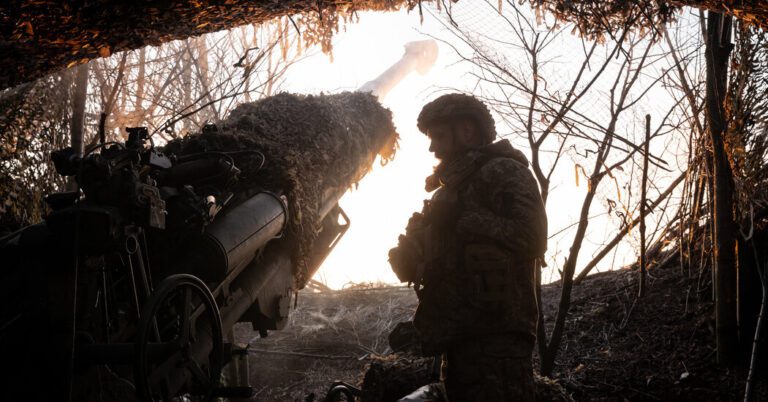
[ad_1]
The top American military commander in Europe warned on Wednesday that Ukraine could lose the war with Russia if the United States did not send more ammunition to Ukrainian forces, and fast.
“The situation is extremely serious,” Gen. Christopher G. Cavoli, the head of the Pentagon’s European Command, told the House Armed Services Committee.
General Cavoli, who is also NATO’s top military commander, said Ukraine’s allies had provided much of the equipment and arms that Kyiv needed to combat the larger Russian military, including all donated fuel and 90 percent of its tanks. But the United States gives Ukraine most of the two critical munitions that are in shortest supply: artillery shells and air-defense interceptors.
“If we do not continue to support Ukraine, Ukraine will run out of artillery shells and will run out of air defense interceptors in fairly short order,” General Cavoli said. “Based on my experience in 37-plus years in the U.S. military, if one side can shoot and the other side can’t shoot back, the side that can’t shoot back loses.”
General Cavoli, a Russia specialist in the U.S. Army, rarely speaks in public. His comments during his annual appearance before Congress to present his command’s budget request and priorities were a sobering assessment of the impact of the U.S. delay in sending Ukraine a $60 billion aid package that congressional Republicans have stalled for six months.
Frontline forces in Ukraine are rationing their artillery shells because they do not have a reliable Western supplier, General Cavoli said. That has allowed Russian troops to outfire Ukrainian forces by a 5-to-1 ratio, the general said. “That will immediately go to 10 to 1 in a matter of weeks” without additional American aid, he added.
“Their ability to defend their terrain that they currently hold and their airspace would fade rapidly — will fade rapidly — without the supplemental, without continued U.S. support,” General Cavoli said.
His command in Germany oversees multinational efforts to train, advise and equip Ukrainian forces, including on how to operate and maintain arms such as M1 Abrams battle tanks, F-16 fighter jets and HIMARS artillery.
General Cavoli, joined by Celeste A. Wallander, the Pentagon’s top policy official for Ukraine and Russia, pleaded with lawmakers to approve the infusion of aid to Ukraine. After months of refusing to bring up the aid bill, Speaker Mike Johnson is now searching for a way to advance it despite a threat from conservative Republicans to oust him if he does.
Nearly every Democrat on the Armed Services Committee urged Mr. Johnson to put the measure to a vote to help stymie President Vladimir V. Putin’s war machine. Representative Mike D. Rogers, an Alabama Republican who heads the panel, also urged support for the infusion of Ukraine aid.
“Congress needs to pass the national security supplemental,” Mr. Rogers said. “If the United States is unable to send additional weapons to Ukraine, Putin will win.”
“Nearly all the money we’re spending to arm Ukraine doesn’t leave this country,” Mr. Rogers said. “It goes directly to U.S. companies and American workers to produce more weapons at a faster pace.”
Ms. Wallander said $48 billion of the bill’s $60 billion would go to defense contractors across 40 states to make arms bound for Ukraine or to replenish Pentagon stockpiles.
The Pentagon officials said that while Russia had lost more than 2,000 tanks and more than 315,000 of its troops had been killed or injured in the war, the Kremlin was reconstituting its army far faster than initial American estimates suggested.
“The army is actually now larger — by 15 percent — than it was when it invaded Ukraine,” General Cavoli wrote in his prepared remarks. “Over the past year, Russia increased its frontline troop strength from 360,000 to 470,000. Russia’s army increased the upper age limit for conscription from 27 to 30, which increases the pool of available military conscripts by two million for years to come.”
Russia has announced plans to restructure its ground forces and expand its military to 1.5 million troops, the general said.
And with that army, Russia not only has designs on seizing as much of Ukraine as it can — it occupies about 20 percent of the country now — but it also poses a long-term security threat to Europe, the Pentagon officials.
“Putin is not going to stop at Ukraine,” Ms. Wallander said.
[ad_2]